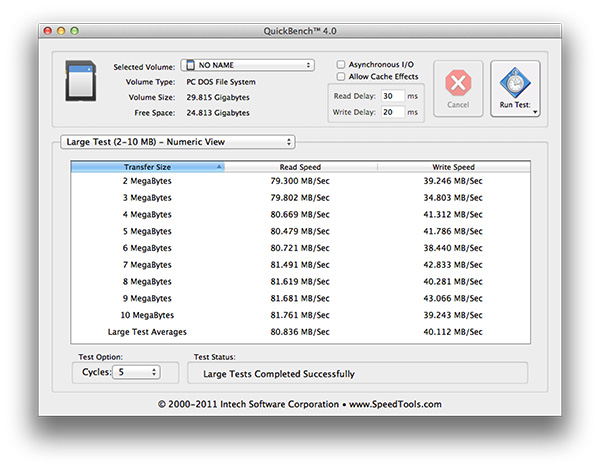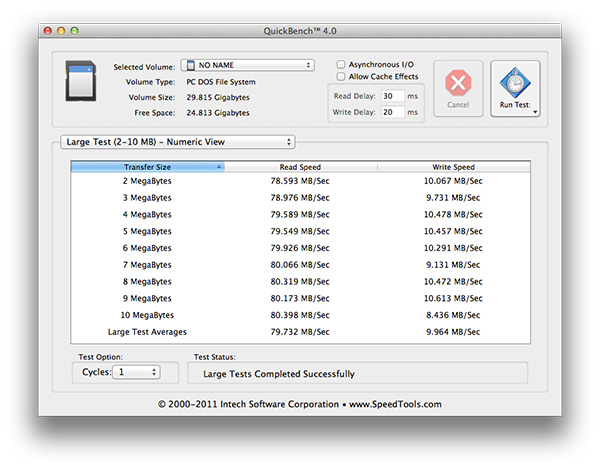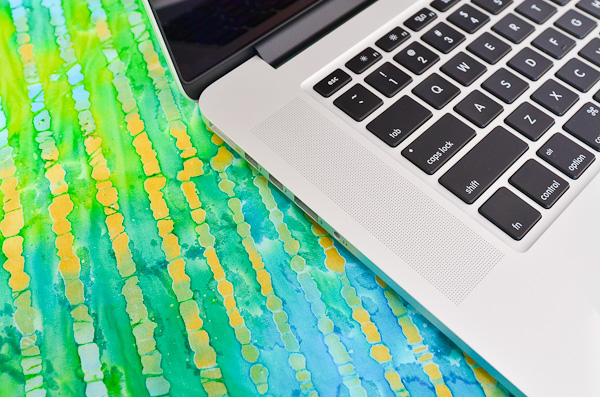The next-gen MacBook Pro with Retina Display Review
by Anand Lal Shimpi on June 23, 2012 4:14 AM EST- Posted in
- Mac
- Apple
- MacBook Pro
- Laptops
- Notebooks
WiFi Performance
The next-gen MacBook Pro is equipped with a decidedly this-gen wireless stack. In other words it uses the same 3x3:3 WiFi solution that was present in the 2011 MacBook Pro and is present in the non-Retina 2012 MacBook Pro as well: Broadcom’s BCM4331. The wireless behavior characteristics are a bit different since this is a physically different chassis, but we’re still dealing with a 3-stream 802.11n solution - not 802.11ac. All three antennas are located in the Retina Display’s housing.
We have seen Apple be conservative with component choices in the past. Deciding to stick with Samsung’s 45nm LP process for the A5X instead of embracing 32nm LP sooner with the 3rd gen iPad is one example that comes to mind. Like a good silicon company Apple appears to mitigate risk in design by sticking with known-good components wherever possible. Major changes to the industrial design are typically paired with comparatively minor silicon changes, and other components are kept as static as possible so long as they don’t overly compromise experience. While 802.11ac dongles and routers are just arriving today, Apple likely froze the Retina MBP’s wireless configuration quite a while ago. Rather than be caught shipping potentially unratified hardware, Apple went the safe route and stuck with 802.11n.

That’s not to say Apple’s wireless implementation is bad. The 15-inch MacBook Pro has been one of the best behaved notebooks on wireless that I’ve had the pleasure of using. The MacBook Pro with Retina Display is no different. Just like before, the best case negotiated physical rate is 450Mbps when paired with a 5GHz 3x3 access point. Unobstructed, within a couple of feet of the AP, I measured as much as 230Mbps to the Retina MacBook Pro. I tested at three different distances from the AP, through walls and on both 2.4GHz and 5GHz bands. Overall performance seemed comparable to the standard 15-inch MacBook Pro, although it’s definitely faster in some areas and slower in others.
| Location 1 | Location 2 | Location 3 | |
| 2011 MacBook Pro (2.4GHz) | 124.0 Mbps | 12.6 Mbps | 61.6 Mbps |
| Retina MacBook Pro (2.4GHz) | 117.9 Mbps | 87.6 Mbps | 44.0 Mbps |
| 2011 MacBook Pro (5GHz) | 186.8 Mbps | 154.6 Mbps | 24.7 Mbps |
| Retina MacBook Pro (5GHz) | 227.7 Mbps | 156.8 Mbps | 33.7 Mbps |
The second test location consistently performed poorly on the 2011 MBP, only on 2.4GHz however. For the most part there were no real surprises otherwise.
The SD Card Reader
It was our own Brian Klug who clued me into the horrible behavior of the 2011 MacBook Pro’s SD card reader. Depending on the SD card used, the integrated SD card reader either performed admirably or was the most frustrating part of the Mac experience. Out of the three SD cards I frequently use: a Patriot LX series card, a Transcend and a new UHS-I Patriot EP Pro, only the Transcend card actually works remotely well with the 2011 chassis. Even then, it’s not perfect. I usually have to insert and remove the card at least once before the reader will recognize it. The LX and EP Pro on the other hand are measurably worse. To get the EP Pro to work in the 2011 MBP’s reader I usually have to push the card in then apply upward or downward force to the exposed edge of the card to get it to read properly. Even then it’ll usually disappear from OS X or be present but read at bytes per second. I doubt this is the fault of the card itself but rather the latest example of incompatibility with the horrible SD card reader in last year’s MacBook Pro.
At least with the cards I’ve tested, the Retina MacBook Pro exhibits none of these issues. Over dozens of insertions I had no issues reading from or writing to all three of these cards, including the problematic ones. I ran a Quick Bench test on the EP Pro as it’s the fastest of the lot and came away with reasonable performance as well. Roughly 80MB/s reads and 40MB/s writes. The numbers are shy of Patriot’s 90/50 spec but quite good.
One of the times I was able to get the EP Pro working in the 2011 MacBook Pro I managed to squeeze in a single Quick Bench run. Read performance was almost identical at 80MB/s, but write performance was far lower at only 10MB/s:
Shortly after the test completed I could no longer write to the drive in the 2011 MBP so I suspect the card reader was acting up again. Needless to say, if you like using SD cards with your MacBook Pro the Retina Display model appears to be much better. That’s not to say there couldn’t be other incompatibilities, but in everything I tested it looks like this problem is finally fixed.
Better Speakers and Dual Mics
Apple is proud of its new speaker design in the Retina MacBook Pro. There’s not a whole lot you can do for tiny laptop speakers but despite shrinking the overall volume of the chassis, Apple has managed to deliver much better sound out of the new speakers in the rMBP. Like most of the upgrades to the next-gen MacBook Pro, you really need to do an A/B comparison to appreciate the difference. And keep your expectations in line with reality, a good set of external speakers are always going to sound better. With that said, the new speakers definitely deliver a fuller, more rich sound than their predecessor. You can still tell you’re listening to some form of integrated speakers, but now they sound distinctly less like they’re coming from a inside a notebook.
In preparation for Mountain Lion's arrival with dictation support, Apple outfitted the next-gen MacBook Pro with dual microphones in order to better focus on your spoken voice and not on background noise. In practice the new mics work reasonably well, rejecting moderate volume background noise. Loud music nearby will still cause interference and as always, accurate dictation requires more than just good quality source audio to get right.













471 Comments
View All Comments
iCrunch - Sunday, June 24, 2012 - link
Agreed. This review is awesome. I hope he's right about the 4K Retina Thunderbolt display, which I'd buy in a heartbeat. One thing I don't get is why so many people and reviewers alike consider the $2,200 price tag extremely and often times too expensive. You're getting the latest and the greatest processors, both CPU and GPU-wise, a generous 8GB of RAM and I find the 256GB SSD to be plenty. After my two 180GB Intel 520 SSD's, this is the largest single SSD that I have ever owned. The upgrades are fair as well as far as doubling the RAM for $200 is concerned. At Apple no less! A few months ago, any setup of 16GB of RAM in 2 SODIMM's was well over $300 and if you go back a few more months, that amount of RAM set you back over a full grand! As in $1,000+I couldn't justify the $600+ price difference for an extra 300MHz in CPU clock and an additional 256GB Flash, though. If the GPU had come with 2GB GDDR5, then maybe, but not as it stands today.
hyrule4927 - Sunday, June 24, 2012 - link
First of all, the 650M may be one of the latest mobile GPU's, but it is pretty far from the greatest. It is a midrange GPU forced to drive an insane resolution with only 1GB of VRAM. And 8GB of RAM isn't "generous", to have any less in a laptop this expensive would be ridiculous. Paying $200 to upgrade to 16GB is a scam, especially considering Apple made the decision to prevent consumers from simply purchasing and installing more RAM on their own (you can find 2X8GB SODIMMs for a bit over $100, no idea what planet you were shopping on where that would cost $1000 at any time in the past year).EnerJi - Sunday, June 24, 2012 - link
I'm sure you can find 8GB of no-name stuff on sale somewhere, but for one example of name-brand memory, Crucial memory goes for $86.99 per 8GB ($173.98 total):http://www.crucial.com/store/listmodule/DDR3/list....
Also, Apple uses low-voltage DDR3-1600, which is lower volume and may be slightly more expensive as a result.
In that light, while $200 to upgrade to 16GB isn't exactly a bargain, it isn't the typical rapacious Apple upgrade prices.
Fx1 - Monday, June 25, 2012 - link
ARE YOU KIDDING? The 650M is running at 900mhz stock! people are clocking this bad boy well over 1050-1100mhzThose are ABOVE 660M GTX Speeds.
Id say Apple has packed in the BEST GPU possible given the thermal limits and size of this notebook.
In windows this MBP will run games at very nice settings and maybe the first Notebook that isn't as thick as an encyclopaedia that can run games on high settings.
Most will never use 8GB of Ram and 16GB is an option so i don't see the issue. Its also custom made which means Walmart RAM prices aren't compatible
hyrule4927 - Monday, June 25, 2012 - link
No, I'm not kidding. Nice capitalization though, it really does wonders for the credibility of your statements. Here are the flaws in your logic. You say that the 650M is the "BEST GPU possible given the thermal limits” with carefully placed capitalization in order to play down the qualifying terms in your statement. Then you suggest overclocking it. If Apple chose this GPU because they were fighting thermal limits, do you really expect it to handle overclocking well? And sure it can run Half Life 2 and Diablo III (an old game, and a game that is hardly demanding by modern standards) at standard resolutions, but users are going to want to game at native resolution on their new retina screen. Too bad Diablo runs at 18 frames per second. It is ludicrous to consider that a playable framerate, and if it can't handle Diablo, it won't be able to handle much of anything at that resolution. Again, that VRAM limitation is a killer. Considering that many popular current games, such as Skyrim, easily consume more than 1GB at 1080p, memory capacity is going to be an enormous bottleneck even when you are nowhere near native resolution. No matter how you want to look at it, a GPU like the 680M is much better suited for that screen, and the 650M doesn't even hold a candle to the performance of that chip.As for the system RAM, while I am sure that you enjoy shopping at Walmart, perhaps you should look on Newegg where you can find a 16GB kit from the manufacturer of your choice for just over $100. Of course you have probably never bought a single computer component in your life, so you can be forgiven for not knowing that. And you describe the "custom" RAM as if it is a selling point. Because everyone knows that proprietary format soldered RAM was included with the best interests of the consumer in mind . . .
iCrunch - Sunday, June 24, 2012 - link
Hi guys, does anyone have this new rMBP (love the abbreviation) and TOSHIBA "SSD "Flash storage"? You can find this in "System Information" under Serial-ATA and it will say either "Apple SSD TS256E" for a Toshiba drive/Flash storage. If you have a Samsung, it will say "Apple SSD SM256E". Naturally, if you have a 512GB drive, it'll display Apple SSD SM(or TS)512E.This should be interesting.
iCrunch - Sunday, June 24, 2012 - link
Thank you, Anand, for the single best and exhaustive review of this gorgeous new powerhouse. I picked one up from an Apple Store, so naturally, I only have the 8GB RAM. I have a 2nd one coming, also a 2.3, but with 16GB and then I will sell this one. That is, if I decide that I truly need and want 16GB. At $200 before any discounts, it sure seems like a worthwhile upgrade either way. There had better not ANYTHING be wrong with ANY other part of my new rMBP, though. lol...pxavierperez - Sunday, June 24, 2012 - link
It's funny how Anand went to great lengths describing, even posting an image as an example, how OSX DPI scaling implementation was superior compared to Window, which really was his point and the point that really mattered to end users, and yet we have Apple haters getting all fumed up just because Anand made one simple typo on the numeric value of Window 7 DPI setting.Sure you can set Windows 7 to scale 200% (2x) but it's flaky, dialog box breaks, inconsistency in rendering objects, and just all around not usable. It's not just all about features it's also about how they are wrapped together to make it work so seamless. Here Apple did a far, far better job than Windows. Which was Anand's point.
spronkey - Sunday, June 24, 2012 - link
All around, it's not a bad review. But I'm disappointed that you still decided to give it an award despite the massive issues:#1 - The soldered RAM.
#2 - The nonstandard SSD form factor.
#3 - The price. Not so much of the machine, but of the upgrades more than anything else.
I'm also disappointed that I didn't see (though may have missed) a bashing of the new MagSafe 2 connector. What a waste of time - just make the chassis ever so slightly thicker. Or, do what other manufacturers do and mould a port around it. Then make it look good.
However. For a Pro machine to be so bastardised... 8GB is not plenty of RAM. Look at the rate we've been increasing RAM requirements over the past few years - it's speeding up, not slowing down. In a year's time, 8GB will probably be standard on half new machines, and in 2 years it'll be very limiting.
I'm also disappointed that these points above aren't also factored in to a good bashing about Apple's very minimal warranty, and very expensive AppleCare product.
I've owned Macs for years - in fact all bar 1 of my portables have been Apple machines; the software/hardware integration just runs circles over the Windows slabs, but I'm really starting to get pissed off with Apple's blatant lockdowns and price gouges. It's anticompetitive and bad taste.
Ohhmaagawd - Sunday, June 24, 2012 - link
I wish it had socketed RAM and a standard SSD too.But fact is most people don't upgrade their machines (although pro users are much more likely). Apple really wanted the thinnest laptop possible with the longest battery life possible. Those goals conflict with upgradability. And I would guess Apple just doesn't care about upgradability. They don't want people opening their cases.
The future for apple laptops is clear: you won't be able to upgrade anything. So better buy what you need to start with.
If you can't deal with that, buy elsewhere.